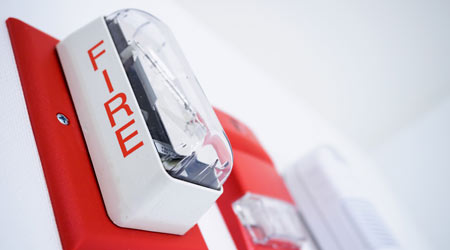
Addressable Fire Alarm Technology Brings Variety of Benefits to Building Managers
August 12, 2016
When it comes to fire alarm systems, facility managers are first concerned with meeting applicable codes to create a safe environment and protect building occupants. Beyond that, easier installation and maintenance, improved operational efficiency, increased uptime, lower costs, and simpler reporting and documentation are important.
Conventional fire alarm systems can accomplish the bulk of these tasks. However, they are limited in flexibility and programmability and more difficult and costly to design, install, reconfigure, expand and maintain. Addressable systems – where each device has a unique address and built-in intelligence to continually report its status to the fire alarm panel – can take safety and value to a much higher level. Addressability has been in use for many years with fire detection, but it is a relatively new development on the notification side of fire alarm systems.
When evaluating fire alarm systems, whether for new construction or system upgrades, migrations or replacements, it’s important to take note of the following benefits and guidelines to help ensure you’re deploying the appropriate mix of new technology for your business.
Notification Appliance Self-Testing
With addressable technology, the days of long, disruptive fire alarm tests are gone. Work that used to take hours or even days can now be done in a matter of seconds, thanks to the availability of self-testing capability for horns, strobes and other notification appliances. Additionally, the addressability built into these systems enables advanced testing functionality, which can help to meet code requirements, reduce business disruption, and lower operational costs.
In some addressable notification systems, each appliance contains a light sensor and a sound sensor that can be activated remotely from the host fire alarm panel. Once activated, the self-test feature momentarily activates each device and sends the results of the test back to the main panel for viewing and archiving. If a device fails the test, it will be identified at the panel, which means the self-testing process meets the testing, inspection and maintenance requirements specified in NFPA 72: National Fire Alarm and Signaling Code.
It takes just seconds to complete the self-test process for an entire notification system. The test can be initiated manually or programmed via the fire alarm control panel to run automatically. This allows testing to be done at a time when it’s most convenient.
This type of notification appliance self-testing has the biggest benefit in environments that are constantly occupied. For example, hospitals must adhere to the same fire protection codes as other buildings, while simultaneously mitigating disruption to help ensure patient comfort and satisfaction. Faster, less intrusive testing helps these facilities to maintain code compliance with minimal interruption to patients and staff.
Granularity of Control for Emergency Messages
Newly emerging addressable speaker technology enables different audio messages to be delivered to specifically targeted areas within a building. These speakers can provide another layer of safety. Rather than just having devices that flash and buzz, speakers can provide clear instructions on what action to take, which can be valuable in an emergency situation.
With addressable technology, the fire alarm panel can be programmed to select exactly which speakers are to be used and what message will be played on them during an emergency. This targeted audio capability enables the delivery of critical, event-specific information exactly where it’s needed. For example, if the smoke detector in the kitchen activates, only the speaker in that area will be triggered. If smoke detectors activate in the kitchen and two surrounding rooms, then the speakers for the entire floor will be put into action.
As fire system technologies evolve, we expect to see more advancements associated with addressable speakers. For example, building owners and managers are increasingly using fire alarm audio for purposes other than emergencies, like broadcasting announcement and background music. When using conventional methods for this, announcements would play across the entire building. With new technologies, users can target specific areas to play the announcements, such as only in the lobby.
Easy Design and Installation, Lower Costs
Conventional hard-wired fire alarm systems have a lot of configuration limitations. They require a labyrinth of wires, which takes a long time to install and leave many opportunities for errors during installation. Addressable systems have a flexible wiring architecture that makes them easier to design and offer greater power efficiency for the appliances.
This technology also enables the use of T-Tap wiring. This method of wiring uses fewer wires and allows more appliances to be connected to a circuit, making for a fast, error-free installation. T-Tapping saves time, money and resources when installing a new system or upgrading or expanding an existing system.
Costs are further reduced because fewer power supplies, notification appliance circuit cabinets and back-up batteries are needed. This provides cost savings during installation, as well as reduced service and maintenance costs over the life-cycle of the system.
While conventional fire alarm systems have their place in fire protection, they don’t provide the advanced features of addressable systems and can be very disruptive to the occupants of a building. Today’s new technology not only offers a more sophisticated level of safety, but it also can save building managers and owners time and money in the installation, operation and maintenance of the system.
Aaron Saak is vice president and general manager of Tyco SimplexGrinnell. He can be reached at asaak@tycosimplesxgrinnell.com. Tom Connell is the senior project manager, notification systems, Tyco Fire Protection Products. He is the former managing director for Advanced Response Concepts. He can be reached at tconnell@tycoint.com.
This Quick Read was submitted by Naomi Millán, senior editor of Building Operating Management magazine, naomi.millan@tradepress.com. To learn more about fire safety systems, go to https://www.facilitiesnet.com/13776bom
Next
Read next on FacilitiesNet












